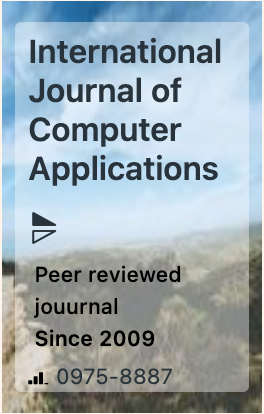The week's pick
Random Articles
Reseach Article
Synergy between Relational and NOSQL Databases for Big Data Management and Shaping the Future of Database Education
| International Journal of Computer Applications |
| Foundation of Computer Science (FCS), NY, USA |
| Volume 187 - Number 6 |
| Year of Publication: 2025 |
| Authors: Shairy, Gourav, Navpreet Kaur Verma |
 10.5120/ijca2025924923
10.5120/ijca2025924923
|
Shairy, Gourav, Navpreet Kaur Verma . Synergy between Relational and NOSQL Databases for Big Data Management and Shaping the Future of Database Education. International Journal of Computer Applications. 187, 6 ( May 2025), 26-31. DOI=10.5120/ijca2025924923
Abstract
With the growing popularity of the internet, the amount of information available is also growing. Big data processing is required for Web Service 4.0 because of the necessity for extremely large-scale, highly concurrent social networking sites that are purely dynamic. The rigorous schema and robust query capabilities of traditional relational databases (RDBMS) have long dominated structured data storage. To meet the requirement for high speed, the current relational database must scale horizontally. As a result, designers must take these factors into account when creating a new class of databases known as NoSQL. This study compares the two database systems, looking at their performance, applicability in modern applications, and architectural tenets. To find out whether final-year students preferred relational or NoSQL databases for project work, a survey was administered to them. According to the findings, NoSQL databases are becoming more and more popular, especially in fields that need to handle unstructured data effectively, flexibly, and scalable. According to one analysis, 70% of students choose NoSQL systems, with MongoDB standing out as a top pick because of its document-oriented design and performance. Relational databases are still useful for applications that require transactional integrity and structured data. In order to educate students, the findings highlight the necessity for academic programs to balance the teaching of both database paradigms. Insights on database selection criteria and the possible future incorporation of industry input to improve instructional tactics are provided in the study's conclusion.
References
- Jing Han, Meina Song, and Junde Song. "A Novel Solution of Distributed Memory NoSQL Database for Cloud Computing", In ICIS 2011, 10th IEEE/ACIS International Conference on Computer and Information Science, 2011.
- F. Chang, J. Dean, S. Ghemawat, W. C. Hsieh, D. A. Wallach, M. Burrows, T. Chandra, A. Fikes, and R. E. Gruber, “Bigtable: a distributed storage system for structured data,” in Proceedings of the 7th USENIX Symposium on Operating Systems Design and Implementation - Volume 7, ser. OSDI ’06. Berkeley, CA, USA: USENIX Association, 2006, pp. 15–15
- Donald R. Deutsch, and Eric K. Clemons, “DBMS Standards: Current Status and Future Directions,” Proceedings of the Sixth International Conference on Very Large Data Bases, VLDB Endowment, vol. 6, pp. 431–433, 1980
- Matallah, H.; Belalem, G.; Bouamrane, K. Experimental comparative study of NoSQL databases: HBASE versus MongoDB by YCSB. Int. J. Comput. Syst. Sci. Eng. 2017, 32, 307–317
- Mishra, O.; Lodhi, P.; Mehta, S. Document Oriented NoSQL Databases: An Empirical Study. In Data Science and Analytics; Springer Nature: Singapore, 2018; pp. 126–136
- Augusto, D.; Morais, W.; Freitas, E. NoSQL real-time database performance comparison. Int. J. Parallel Emergent Distrib. Syst. 2018, 33, 144–156.
- Johnson, P., Wang, Y., & Garcia, S. (2019). Exploring the integration of NoSQL and relational databases for efficient big data processing. International Journal of Data Management, 22(7)
- Smith, J., Brown, M., & Lee, A. (2020). The synergy between relational and NoSQL databases in big data management: A hybrid approach. Journal of Big Data Technologies, 15(3), 234-249.
- Carvalho, I.; Sá, F.; Bernardino, J. NoSQL Document Databases Assessment: Couchbase, CouchDB, and MongoDB. In Proceedings of the 11th International Conference on Data Science, Technology and Applications, Lisbon, Portugal, 11–13 July 2022; pp. 557–564.
- Eeshan Gupta et al., “Attribute-Based Access Control for NoSQL Databases,” Proceedings of the Eleventh ACM Conference on Data and Application Security and Privacy, Association for Computing Machinery, New York, NY, USA, pp. 317–319, 2021.
- Jing Han, Haihong E, Guan Le,Jian Du, “Survey on NoSQL Database,” IEEE, pp. 363- 366, 2011.
- Nayak, A.; Poriya, A.; Poojary, D. Type of NOSQL Databases and its Comparison with Relational Databases. Int. J. Appl. Inf. Syst. 2013, 5, 16–19
- SHEN D R,YU G,WANG X T,et al. Survey on No SQL for Management of Big Data[J]. Journal of Software, 2013, 24(8):1786- 1803.
- R Hecht, S Jablonski, “NoSQL Evaluation,” International Conference on Cloud and Service Computing, IEEE, pp. 336-338, 2011.
- Neal Leavitt " Will NoSQL Databases Live Up to Their Promise?" IEEE Computer Society 0018-9162/10 © 2010 IEEE
- Bansel, H. González-Vélez and A. E. Chis, "Cloud Based NoSQL Data Migration," 2016 24th Euromicro International Conference on Parallel, Distributed, and Network-Based Processing (PDP), Heraklion, 2016, pp. 224-231.
- Matallah, H.; Belalem, G.; Bouamrane, K. Experimental comparative study of NoSQL databases: HBASE versus MongoDB by YCSB. Int. J. Comput. Syst. Sci. Eng. 2017, 32, 307–317.
- Mishra, O.; Lodhi, P.; Mehta, S. Document Oriented NoSQL Databases: An Empirical Study. In Data Science and Analytics; Springer Nature: Singapore, 2018; pp. 126–136
Index Terms
Keywords

